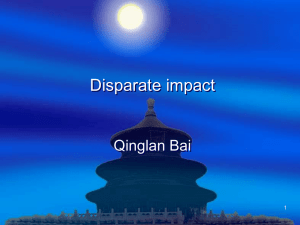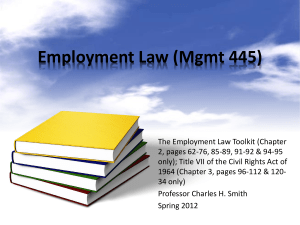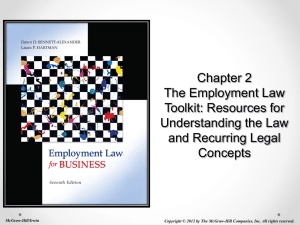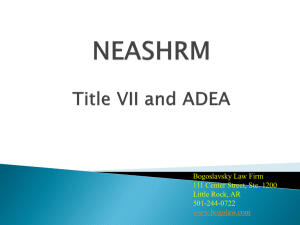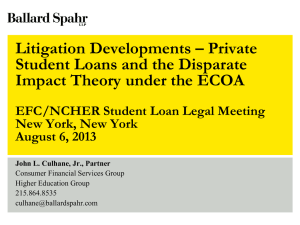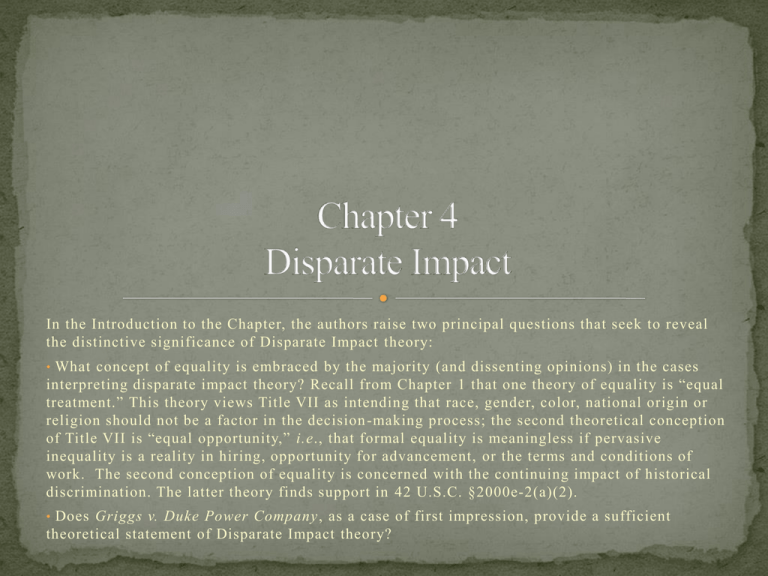
In the Introduction to the Chapter, the authors raise two principal questions that seek to reveal
the distinctive significance of Disparate Impact theory:
• What concept of equality is embraced by the majority (and dissenting opinions) in the cases
interpreting disparate impact theory? Recall from Chapter 1 that one theory of equality is “equal
treatment.” This theory views Title VII as intending that race, gender, color, national origin or
religion should not be a factor in the decision -making process; the second theoretical conception
of Title VII is “equal opportunity,” i.e., that formal equality is meaningless if pervasive
inequality is a reality in hiring, opportunity for advancement, or the terms and conditions of
work. The second conception of equality is concerned with the continuing impact of historical
discrimination. The latter theory finds support in 42 U.S.C. §2000e-2(a)(2).
• Does Griggs v. Duke Power Company, as a case of first impression, provide a sufficient
theoretical statement of Disparate Impact theory?
The removal of barriers to employment which have historically favored
white employees (a Supreme Court case of first impression concerning the
meaning of Title VII);
In Griggs, Black employees, using the vehicle of a class action, challenge the Power Company’s use of
a high school diploma requirement and a nationally accepted high school equivalency test as a
precondition to employment in any job other than the company’s lowest “laborer” jobs, or transfer from
“coal handling jobs” to any “inside” department (Operations, Maintenance or Laboratory jobs). The
Power Company instituted such requirements immediately following the enactment of Title VII of the
Civil Rights Act.
Neither the education or test requirements were intended to, nor did they in fact measure the ability to
perform the jobs in question.
The District Court found that the Power Company had, prior to the enactment of Title VII, intentionally
discriminated in hiring, transfer, and promotion on the basis of race.
The Court of Appeals held that, in the absence of discriminatory motive, an employer’s use of facially
neutral educational requirements and general intelligence tests is permitted, without qualification, by
Title VII. The Supreme Court reversed, holding that when such requirements significantly disqualify a
disproportionate number of Black applicants, they violate Title VII.
The legislative intent of Title VII and the requirement of job-
relatedness
Noting the admission of the Power Company that the education and test requirements disqualified a
disproportionate number of black employees, the Court explained that while such requirements are not
per se invalid, intelligence must have a means of articulation so as to manifest itself in a testing process
that is used to determine qualifications for employment. On this issue, the Court found that, at the time
of this case, and long prior, black citizens had received inferior education in racially segregated schools
in North Carolina (noting the prohibition of literacy tests as a precondition to voter registration. See e.g.
United States v. Louisiana, 225 U.S. 353 (E.D. La. 1963), affirmed, 380 U.S. 145 (1965).
Alluding to Aesop’s fables, the court held that the applicant’s condition must be viewed in relation to
the allegedly equal opportunity to be hired or transferred, and that opportunity must be available to all
applicants who can perform the requirements of the job. Viewed in this context, the educational
requirements and intelligence tests were introduced by the employer with no study of their relationship
to successful job performance. In fact, the Court observed, the record in the case demonstrated that
current white employees who lacked the high school diploma and who had not completed the tests
performed satisfactorily in the jobs sought by black applicants and employees. This finding is fatal to
the employer’s claim under disparate impact theory. In determining the presence or absence of racial
discrimination in the selection process, the point of reference of disparate impact theory is not the
employer’s racial motive, but the employer’s use of artificial qualifications for a job, which exclude
significant numbers of protected class employees. The focus is on “consequences” of job requirements,
not the employer’s motive. This aspect of Title VII is concerned with equal opportunity.
Note the Court’s observation that, at the time of the case, the EEOC had issued Guidelines
specifying that employers could use only job-related tests, and that this guidance by the
enforcement agency responsible for Title VII was entitled to great deference.
And note the Court’s examination of legislative history, concluding that Congress was explicit
in its intention that the language of Title VII would not require employers to hire applicants
who were unqualified, when measured by job-related qualifications, simply because they were
members of a protected class specified in Title VII. This Congressional dialogue led to the
adoption of the testing provision codified in § 703(h) of the Act. Thus EEOC’s interpretive
guidance is consistent with legislative intent. Nothing in Title VII precludes the use of tests as
a measurement for selection, so long as such tests legitimately measure job performance. This
conclusion in fact is axiomatic with Title VII’s purpose – to make race (color, sex, religion, or
national origin) irrelevant in themselves as qualifications for a job.
The Court did not explicitly rely on the language of §703(a)(2) to support Disparate Impact
theory until its decision in Connecticut v. Teal, eleven years after Griggs. Note the language of
(a)(2): The word “discriminate” is not used; instead the section speaks of “limitations and
classifications” that would deprive individuals of employment “opportunities.”
Comparing Disparate Impact and Disparate Treatment
theory regarding the goals of Title VII
Defining discrimination in terms of consequences rather
than motive applies Title VII to preclude employment
practices that have a disproportionate negative impact on
protected groups unless the employer can show that the
employment practice is “job related and justified by
business necessity.”
Thus Disparate Impact theory seeks to abate artificial
institutional barriers to equal employment opportunities for
minorities and women, i.e., to keep institutional choices
connected to job-relatedness and business necessity.
A Disparate Impact plaintiff must allege that an identified employment practice selects
candidates for hire or promotion in a (here) racial pattern significantly different from the
general pool of applicants (by a statistical showing that the observed number of hires or
promotions is significantly different from that to be expected if neutral selection criteria
were used);
Once this is established, the employer must show that the practice is “job-related and
business-necessary;”
If the employer meets this requirement, the plaintiff must show alternative selection
devices that would remove the undesirable (racial) effect consistent with the employer’s
legitimate interest in successful performance of the job in question;
The goal of this analytical approach is to create the expectation that an employer will
insure validation of its employment practices, including tests, by either:
Content-based validation (replicating the content of the job, e.g., asking an applicant
for a word-processing job to complete an exemplary word processing exercise); or
Criterion-based validation (presenting a statistical correlation between the selection
procedure and job performance, e.g., having current employees take a test and then
comparing the test results with their current performance ratings).
Eleven years after Griggs, the Court rejected an employer’s assertion that it should not be
liable to protected class employees who were rejected for promotion, if the overall result of the
promotion process produced “an appropriate racial balance.”
The case arose from the State of Connecticut’s use of a written examination as a part of its
promotion process (in the State’s Department of Income Maintenance). Of the 329
candidates, 54% of the self-identified 48 black applicants taking the test passed approximately 68% of the passing rate for the 259 white applicants.
The black employees who failed the test filed a disparate impact claim, and while the case
was pending in federal court, the employer made promotions from an eligibility list
generated by the examination (examining past work performance, seniority and
supervisory recommendations); the employer also then considered its concern for
promoting a significant number of minority employees. As a result of this approach, 23%
of eligible black employees were promoted as compared to 13.5% of eligible white
employees.
The employer alleged that this result should be a per se defense to plaintiff’s allegation
that the test in question disproportionately disqualified black employees and was not jobrelated.
The four justice majority reasoned that the basis of the State’s
defense ignores the fact that Title VII guarantees individual
protected class employees the right to compete equally with
white workers on the basis of job-related criteria; this can be
done only by eliminating the use of artificial barriers that
disproportionately disqualify members of a protected class
(here black employees);
This right belongs to every employee who seeks to be hired or
promoted, i.e., each black employee who was disqualified by
the test, in spite of the State’s promotion of other black
employees from the pool that remained, based on its desire to
achieve a satisfactory representation of minority employees in
supervisory ranks. In this sense Disparate Impact theory
recognizes the subtle practices and devices that foster racially
stratified jobs to the disadvantage of minority employees.
Four justices dissented, arguing that, although Title VII
was intended to protect individuals and not groups,
nevertheless in Disparate Impact cases, unlike Disparate
Treatment cases, the plaintiff’s’ proof of discrimination is
by inference, and s/he is not at the center of the case.
The dissent cautioned that the majority’s holding could
encourage employers to either eliminate tests altogether or
rely on expensive, job-related validation that might in the
end be disapproved (Is this an argument with a logical
fallacy, or an argument that employers should not have to
invest in the cost of test or criteria validation?)
Watson, a bank teller (with seven year’s experience) at Fort Worth Bank, applied for
four higher level positions for which she deemed herself qualified, but lost out to
white co-workers on each occasion. Her case raised the question whether Disparate
Impact analysis can be applied, when the employer justifies its selection process by
relying on the subjective judgment of supervisors, rather than more formal criteria in
making promotion decisions. A unanimous Court held that Disparate Impact
analysis does apply, and is not overcome by the mere allegation that the employer
relies on supervisory discretion in making promotions.
The Court held without dissent that, while reliance on supervisory discretion is not
per se discriminatory, such supervisory discretion may be influenced by
subconscious stereotypes and prejudices that do not rise to the level of intentional
discrimination. If an employer’s system of undisciplined discretion has precisely the
same effect as a system pervaded by intentional discrimination, [Title VII’s
proscriptions should apply]” (emphasis supplied).
Noting the employer’s argument that the difficulty of validating subjective criteria
would make it impossible to defend claims of discrimination, and/or would lead
employers to adopt furtive racial quotas – the Court observed that Title VII requires
no employer to grant preferential treatment to any protected class individual or
group because of past discrimination (Citing 42 U.S.C. § 2000e -2(j) and Albermarle
Paper Company v. Moody, 422 U.S. 405 (1975).
How the analytical approach to “subjective criteria” cases satisfies employer
concerns: First, in a case where a plaintiff challenges a “subjective” decisionmaking process, s/he must identify the specific employment practice that is being
challenged, i.e., that is responsible for the statistical disparities that allegedly reveal
disparate impact. Second, the plaintiff must present statistical evidence sufficient to
show that the challenged practice has resulted in the disproportionate exclusion of
applicants or candidates in the protected group, i.e., an inference of causation.
Finally, when the employer comes forward with evidence that its practices are
legitimate, the plaintiff must show that other selection devices which do not have the
undesirable racial result would serve the employer’s interests.
In 1991, Congress codified Disparate Impact theory in 42 U.S.C. § 2000e -2(k)(Sec.
703(k)(1)(A)-(C), and specifically stated the analysis to be applied in Disparate Impact cases:
The Court re-affirmed Griggs’ requirement that practices which have a disparate impact on
members of a protected class must be shown to be “job-related for the position in question and
consistent with business necessity.” The plaintiffs bear the burden of this initial showing, and
must do so by demonstrating: (i) that either a specific practice causes a disparate impact, or
that a process that cannot be separated into specific components for analysis has a statistically
significant negative impact on members of a protected class and is not job-related and
consistent with business necessity, or (ii) that the plaintiffs have suggested an alternative
practice that avoids the negative result with respect to the protected class and that the employer
has refused to adopt that alternative.
Recall that the 1991 Civil Rights Act also adopts new provisions in Disparate Treatment cases,
including a provision for jury trials, as well as compensatory and in some cases punitive
damages where intentional discrimination is proven.
The case book authors illustrate the post-1991 CRA jurisprudence in two cases, Lanning v.
Septa, a Third Circuit case, and Ricci v. DeStefano, a Supreme Court case.
In Lanning I, the Third Circuit Court of Appeals held that, under the 1991 CRA, a
discriminatory “cut-off score” on an entry level employment exam must be shown to measure
the minimum qualifications necessary for successful performance of the job in question.
The employer, a regional mass transit authority, admitted that its adoption of a physical
fitness test had a disparate impact on women applicants for transit police positions, but
defended its use of the test based on the “expert opinion” of the designer of the test, Dr.
Paul Davis. Dr. Davis admitted that the test’s requirement of a 1.5 mile run in under 12
minutes might lack content validity, but asserted that it was an accurate measure of the
aerobic capacity necessary to perform the job (an apparent “construct validity” argument
(see note 7, page 227). The case thus permitted a direct test of Disparate Impact theory
under the 1991 CRA – and particularly the “job-related and business necessary” aspect of
the analysis.
The Court held that the “business necessity” requirement reaffirmed by the 1991 CRA
required that the minimum cut-off imposed by Dr. Davis’ test must measure the minimum
requirement for successful performance of the job of transit police officer. The court
rejected the argument that the required test must merely bear some legitimate relationship
to the job in question (a vestige of the Ward’s Cove case that was rejected by Congress in
the 1991 CRA).
On remand, the trial court approved the test, and that ruling was again appealed.
On appeal, the Third Circuit affirmed the approval of the transit authority’s use of the test
developed by Dr. Davis, observing that the transit authority produced sufficient evidence that
the test measured the minimum requirements for both the pre-hire training of transit officers,
and the job itself. The court thus held that the admitted disproportionate rejection of female
applicants based on their performance on the test did not violate Title VII.
In an opinion that clearly deferred to employers where the jobs at issue involved the protection
of public safety, the court held that transit police were infrequently but necessarily required to
run down persons fleeing the scene of a crime in order to effectuate arrest.
The court did recognize that Davis’ test research was not undisputed, but found evidence of a
correlation between successful “run time” and a success rate “on the job standards” (slightly
confusing language).
Finally, the court found that women who trained before applying were able to pass the test – a
factor that supported the transit authority’s concern for the commitment of its officers to
physical fitness.
Judge McKee, writing in dissent, noted that the test in question was administered when a
person first applied for a position as a transit police officer, not when that applicant completed
police academy training and actually started the job. Thus the transit authority took no action
to retest or otherwise determine whether a previously qualified male officer could still pass the
test – and incumbent officers are not required to do so. Judge McKee also questioned Dr.
Davis’ decision to determine his own “cut-off” score despite the recommendations of 20
experienced officers.
In 2009, in a 5-4 decision in Ricci v. DeStefano, the Supreme Court strictly limited an
employer’s voluntary efforts to act preemptively to remedy the probable disparate impact of its
established selection procedures.
Ricci is a “reverse discrimination” lawsuit challenging the decision of the City of New
Haven to disregard the results of test scores that disproportionately excluded minority
applicants for promotion within its firefighter ranks.
A bare majority of the Supreme Court held that the City’s decision not to rely on the test
results, because to do so could lead to liability for disparate impact liability, was a “raceconscious” decision in violation of Title VII, unless the City could demonstrate the
probability that the test would be found to be statistically discriminatory and not jobrelated and business necessary.
The fact context: The City’s tests for promotion to lieutenant and captain positions were
developed by IOS, a test consultant. The content validation process conducted by IOS is
explicitly described in the Court’s opinion at page 269 of the case book. The
administration of the tests, and the requirements of the City’s merit system resulted in the
initial selection of 10 candidates, all white, for lieutenant vacancies and 9 whites and 2
hispanic candidates for captain vacancies. No black candidates were selected.
The City’s Civil Service Board met to consider the results of the test. It considered the advice
of its Department of Human Resources and its General Counsel that the test had a significant
disparate impact on minority candidates; the conflicting opinions of candidates who spoke at
the meeting both for and against the use of the test results; and the opinion of 3 experts in the
field of test development or race and culture. In the end it decided not to rely on the tests until
they could be satisfactorily validated.
The 5 member majority of the Court decided the case on the fundamental premise that the
City’s action to delay use of the tests because of its concern for disparate impact violates the
disparate treatment provisions of Title VII, unless the likelihood of disparate impact could be
proven – beyond proving the statistical disparity based on race per se. The Court did explain
that the City could act where it knew in fact that its test results violated Title VII’s disparate
impact provisions, and that an employer is not required to wait until it has been found liable
under Title VII. However, the majority held that a “good faith belief” regarding the validity of
its reliance on the tests is insufficient to justify its decision.
Citing City of Richmond v. J.A. Croson Co., 488 U.S. 469 (1989)(another divided opinion), the
Court held that the City’s defense of its decision must be based on a “strong basis in evidence”
that its remedial efforts were necessary to avoid disparate impact liability.
The majority – indeed the plaintiffs – admitted that the statistical disparities in pass rates fell well below the
80% threshold that triggers the disparate impact provisions of Title VII under EEOC guidance (See 29 C.F.R.
§ 1607.4 (2008). However, the majority found that this statistical disparity alone falls short of the strong
showing required for a finding of liability under Title VII’s disparate impact language.
The majority stated in conclusory terms that there is no question that the examinations were job-related
and consistent with business necessity.
The majority also found that the City presented no evidence of an equally valid, less discriminatory
testing alternative [despite such suggestions by an industrial/organizational psychologist retained by the
City to evaluate the apportionment of written & oral scores as contrasted with the use of assessment
centers where content-based validation could be conducted (a method of validation used in 2/3 of cities
in this context). In fact, the majority reviews the expert’s testimony and then simply says that it is
insufficient, standing alone].
Justices Ginsburg, Breyer, Stevens and Souter emphasize two factors: (1) That historical deliberate
racial discrimination in the field of firefighting is beyond doubt; and (2) That the majority unjustifiably
ignored substantial evidence in the record of multiple flaws in the tests used by the City. The dissenting
justices also directly challenge the majority’s assertion of the potential conflict between Title VII’s
disparate treatment and disparate impact provisions, and emphasize that the twin provisions seek the
elimination of workplace discrimination and the promotion of equal employment opportunity.,
including through “voluntary compliance.”

